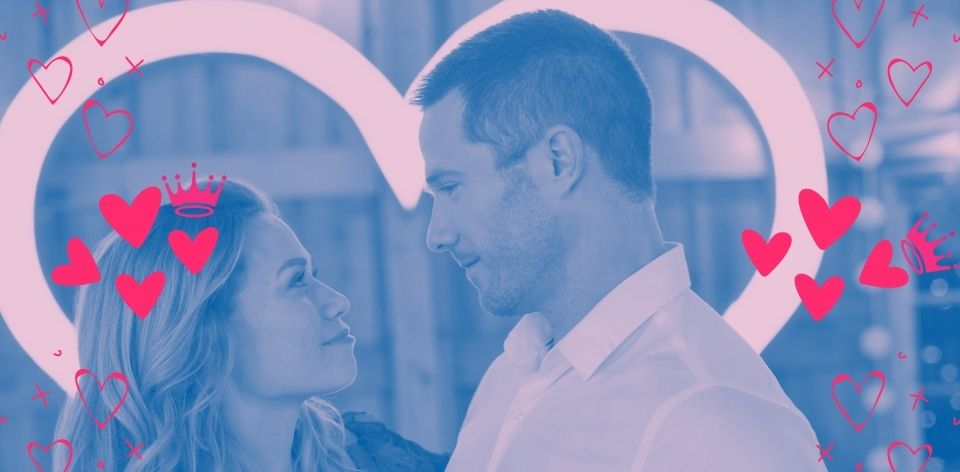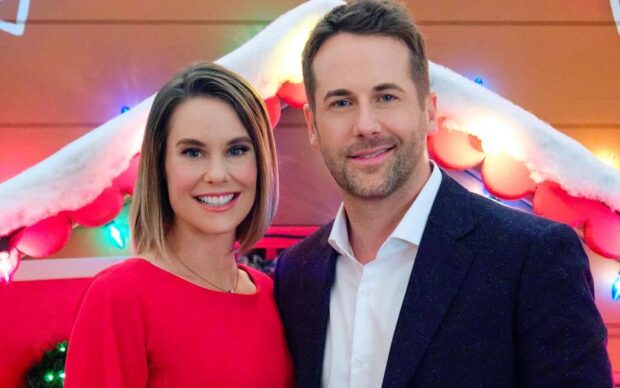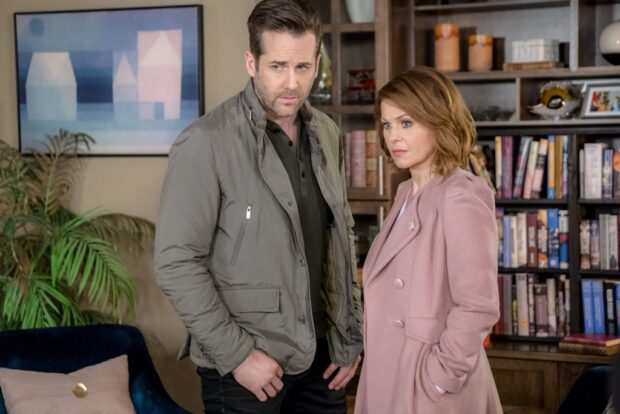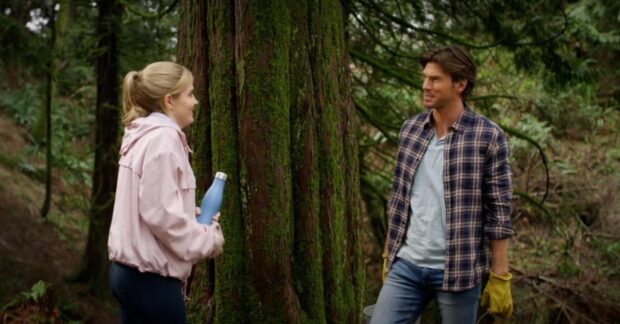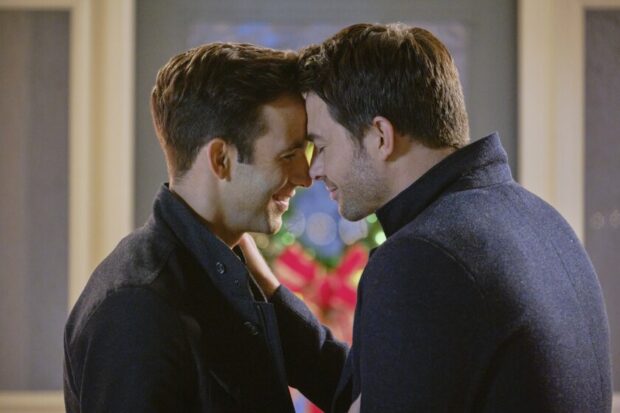So, the Christmas of 2020 was the end of a long and difficult year for many of us. As is the tradition most years, we started in on the Christmas movie binging. Old favourites mingled with new, magic was found, and many foodstuffs were eaten. Yet on the ninth day of Christmas, as several ladies danced next to the maids a-milking, something magical happened.
We’d already dipped our toes into Netflix’s Holidate, and the mainstream release Happiest Season, when a random film fell into our laps. Starring Ashley Williams and Niall Matter, it featured a single mum with a houseguest at Christmas. Mistakes were made, hearts were won, and the true meaning of Christmas was discovered. Yet we had so many questions. How did lead Maggie (Williams) afford a palatial house with a barn and dozens of Christmas trees on a local teacher’s salary? Actually, why would anybody need more than one tree? Were there any more films like this?
The movie was the gloriously titled Never Kiss a Man in a Christmas Sweater, and the answers (in order) were: it doesn’t matter, yes they do, and oh honey you have no idea. We were very quickly mainlining flicks like Christmas She Wrote, A Blue Ridge Mountain Christmas, and Five Star Christmas — and we were hooked. We developed bingo cards and dug a little deeper. It didn’t take a Gourmet Detective to know that this was a bigger world than expected.
Hallmark cinematic universe
For the uninitiated, Hallmark produces around 100 original films a year. From their various cable roots in the 80s and 90s, the modern Hallmark Channel debuted in 2001 and has expanded into an empire of films with punny titles like Bacon Me Crazy or Love At First Bark.
The Hallmark brand comes in two distinct flavours. There’s the regular seasonal Hallmark Channel (HC) releases from New Year New Movies, through Loveuary, Spring Fling, Summer Nights, June Weddings and the Fall Harvest. Hallmark Movies & Mysteries (HMM) follow suit, usually with what’s called an umbrella or ‘wheel series’ of films with titles like Aurora Teagarden Mysteries, Garage Sale Mysteries, Crossword Mysteries and Murder, She Baked. Some of them, like the Aurora Teagarden adaptations starring Candace Cameron Bure, have produced as many 17 films – with an 18th due imminently.
Naturally, there’s the stars of Hallmark. In addition to Bure, who is Hallmark royalty at this point, folks like Rachael Leigh Cook, Danica McKellar (The Wonder Years), Lacey Chabert, Autumn Reeser, Cameron Mathison, Alicia Witt and Holly Robinson Peete turn up regularly, especially at Christmas. The late, great Betty White starred in a film with Jennifer Love Hewitt (The Lost Valentine). Did you ever want to see Rory Gilmore and Shazam together? Well, Hallmark did that in 2013 with Remember Sunday, starring Alexis Bledel and Zachary Levi. There was a Christmas at Dollywood. Even Carrie Fisher turned up in the gloriously titled It’s Christmas, Carol!
Of course, all of this programming pales in comparison to the Christmas season. Earning the network their highest ratings, the Countdown to Christmas has been an annual tradition for over a decade – and it just keeps getting bigger. At the start of the 2010s, they showcased about 12 films a year, but that has grown to a 40 film slate that starts in October and rolls straight through to late December. It’s such an important part of their lineup that when the Coronavirus pandemic shut down most sets in March 2020, all production efforts were put into saving 39 out of the 40 planned films. It’s a kind of Christmas miracle – one that would make for an excellent Hallmark movie.
Marvel: eat your heart out.
Bingo!
Hallmark Movies may seem like a simple affair, with the kinds of narratives that could be scribbled out on one of the eponymous greeting cards. Many fans and critics have pointed out that there are basically a dozen plots across the myriad of films, almost like the romantic version of the Hero’s Journey. So why do they continue to appeal?
“There’s a lot of dopamine and oxytocin that gets released in watching these things,” said Prof. T. Makana Chock, a researcher of media psychology at Syracuse University’s Newhouse School of Public Communications, in an interview with The Lily. “They can be very de-stressing. They make you feel happier.” Which might explain why people have rediscovered them so heavily in the last few years, when literal escapism and travel has been difficult or off-limits. They are like a mental vacation from our lives.
Yet as my partner and I developed our bingo cards, we couldn’t help but wonder if it was more than that. Themes of ‘big city problems’ or ‘career versus romance’ set against the backdrop of thriving and/or failing family businesses in quaint small towns just kept turning up. Are these targeted alternatives for city dwellers, fodder for those who simply craved cheese at holiday times, or is Hallmark holding up a mirror to the audience?
Take one of the more recent offerings, Where Your Heart Belongs (2022). The aggressively traditional plot is ruggedly anti-city and seemingly skeptical of womenfolk having careers at all. It follows a New York-based marketing executive (Jen Lilley) struggling to keep her clients. She returns home to a rural maple farm to reconnect with her roots, but apparently goes back in time as well. (Note: there is no actual time travel, but that is also a Hallmark trope). The town is anti-technology, and the romantic lead is a caricature of a woman who is unable to relate to rural folk folk due to her, you know, having a career. There’s also a running thread about someone finding their own cousin hot, so these on-screen small town values are a bit of a mixed bag.
Every rose has its thorn
Which brings us to some of the more conservative aspects of the network. Even if some audiences view these films ironically, Where Your Heart Belongs is not an isolated case. The main romantic plots are overwhelmingly heteronormative and conservative. It has taken a long time for Hallmark to be more than nominally racially inclusive, and it wasn’t until 2020 (!) that Hallmark included their first same-sex couple as supporting characters in holiday film The Christmas House.
Letterboxd user rico mcpato made this illustrative list simply titled ‘Christmas movie posters with white heterosexual couples wearing red and green,’ which might double as a plot description for all of them as well. (Note that not all of these posters are from Hallmark movies). By comparison, rival network Lifetime has been a little faster to adopt representation and inclusion, with multiple LGBTQIA+ lead characters, although these too have only been in the last couple of years.
So, it’s probably no surprise that Hallmark can trace its roots back to content blocks on the American Christian Television System (ACTS) and the Vision Interfaith Satellite Network (VISN), and at least some of that audience is still invested. In 2019, the Hallmark Channel showed an ad for wedding company Zola, one that briefly featured a lesbian couple kissing at their wedding. The One Million Moms group complained, and Hallmark and parent company Crown Media yanked the ad citing it was too ‘controversial.’ Of course, Hallmark was then forced to backpedal when GLAAD rightfully pondered how the existence of LGBTQIA+ people was ‘controversial.’ So, the timing of The Christmas House probably wasn’t coincidental, with Crown Media wisely choosing not to alienate their LGBTQIA+ viewers completely.
Yet these very ‘traditional’ Hallmark themes persist. It’s a world where men with precocious children are single because their wives are dead. Where attics and basements are filled with a Very Special Object that links people to the past. Where the older community has sage advice for youngsters, and no problem is so big that baking can’t fix it. Perhaps these plots simply reinforce ideals that the core audience already holds, and reassure them that the ‘real’ America exists outside of New York and LA. Even if most of the movies are shot in Canada.
Career versus…love?
Yet here we are, still watching.
While I won’t pretend that the underlying motivations of the parent company don’t worry me — I wrote over 1,000 words about it after all — I ultimately treat these like a blockbuster film. Intellectually, I know the problems exist. It’s the same as knowing the issues that accompany a monoculture resulting from Disney buying all of the things, but still being first in line for the eventual Alien Vs. Marvel Jedis Christmas Special. I can watch all the critically acclaimed festival favourites, and still have no filter when it comes to eating the cinematic equivalent of fistfuls of raw cookie dough.
Similarly, as Hallmark’s 2022 The Wedding Veil trilogy crosses over three of its biggest stars – Lacey Chabert, Autumn Reeser and Alison Sweeney – that dopamine kicks in and we bliss out for a time. They provide the resolutions that life doesn’t always muster, and they never have to look beyond happily ever after.
Now, if you’ll excuse me, there’s a big city gal who has just been given a writing assignment in the heartland. I wonder if she’ll find Mr. Right?

